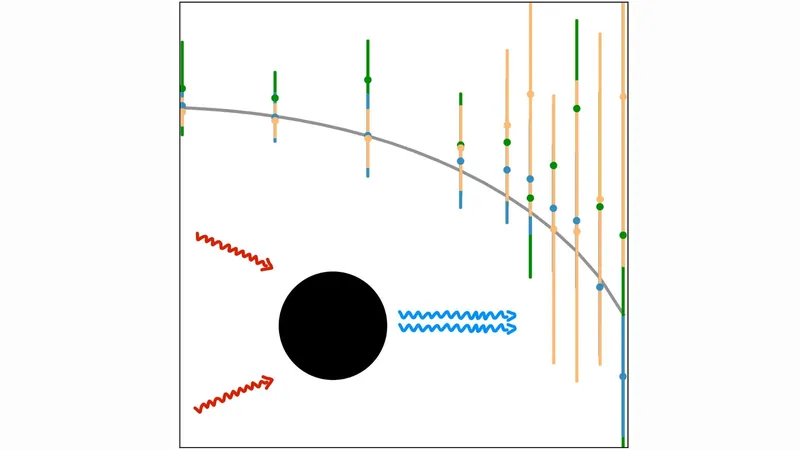
Unlocking the Mysteries of Black Holes: New Insights into Gravitational Waves
2025-06-25
Author: Sarah
A Breakthrough in Understanding Black Hole Mergers
Recent research published in *Physical Review Letters* has unveiled a groundbreaking theoretical framework suggesting that the gravitational wave signals emitted during black hole mergers are far more intricate than previously thought.
When two black holes collide, the aftermath isn't just a simple fusion; the newly formed black hole resonates like a struck bell, producing what scientists refer to as the "ringdown" phase. This phase is crucial, as it carries vital information about the properties of the final black hole.
Reverberations in Space: The Discovery of Quadratic Mode Couplings
This research reveals that these cosmic reverberations are influenced by complex quadratic mode couplings—secondary oscillations that arise when primary oscillation modes interact in a nonlinear manner. Although Einstein’s general relativity predicted such behavior, it had never been fully mapped out until now.
Huan Yang, a co-author from Tsinghua University, remarked, "My fascination with nonlinear phenomena in general relativity led me to study the nonlinear ringing of black holes as new theoretical tools emerged. This work clarifies long-standing discrepancies between theoretical expectations and numerical simulations regarding black hole behavior."
Redefining Oscillations: More than Just Quasinormal Modes
In the tumultuous aftermath of a black hole merger, the resultant black hole undergoes oscillations in characteristic patterns known as quasinormal modes (QNMs). These modes represent the natural frequencies at which the black hole vibrates as the gravitational distortions settle back into equilibrium. Previous research primarily concentrated on these linear modes, but this work emphasizes the complex interactions of modes as they generate additional, secondary oscillations.
Advanced Techniques for Analysis
To analyze these interactions, the research team developed two innovative methods: a complex contour technique and a hyperboloidal time-slicing approach that simplifies the mathematics involved by employing specialized coordinate systems.
Revolutionizing Theoretical Predictions
The team identified four distinct interaction channels, revealing surprising results, including the complete disappearance of one specific channel regardless of black hole characteristics. This finding establishes a new fundamental constraint on black hole dynamics.
Yang noted, "This framework, rooted in over fifty years of Black Hole Perturbation Theory, now aligns with numerical simulations, resolving earlier inconsistencies and enhancing our theoretical understanding."
Gravitational Waves: A New Era of Observations
This theoretical advancement coincides perfectly with the field of gravitational wave astronomy, as current detectors like LIGO and Virgo are on the cusp of detecting these subtle secondary signals. Upcoming next-gen instruments, like the Cosmic Explorer, promise even greater sensitivity.
The researchers determined that several quadratic modes may produce observable signals with high signal-to-noise ratios, making it imperative for future detectors to effectively capture these nuances during the ringdown phase.
Beyond Current Understanding: The Future of Black Hole Research
Understanding these nonlinear behaviors holds the potential to provide experimental validation for general relativity in extreme gravitational contexts. Divergences between observed and predicted coupling strengths could also suggest phenomena that transcend Einstein's legacy.
Yang is optimistic about future exploration: "We aim to progress beyond simply quadratic effects to encompass all nonlinear behaviors in black hole ringdowns, ultimately constructing an intricate ringdown waveform that captures the entire sequence of events from merger to decay."
This exciting advancement in black hole research not only deepens our understanding of the universe but also challenges and enriches established theories, paving the way for future discoveries.





 Brasil (PT)
Brasil (PT)
 Canada (EN)
Canada (EN)
 Chile (ES)
Chile (ES)
 Česko (CS)
Česko (CS)
 대한민국 (KO)
대한민국 (KO)
 España (ES)
España (ES)
 France (FR)
France (FR)
 Hong Kong (EN)
Hong Kong (EN)
 Italia (IT)
Italia (IT)
 日本 (JA)
日本 (JA)
 Magyarország (HU)
Magyarország (HU)
 Norge (NO)
Norge (NO)
 Polska (PL)
Polska (PL)
 Schweiz (DE)
Schweiz (DE)
 Singapore (EN)
Singapore (EN)
 Sverige (SV)
Sverige (SV)
 Suomi (FI)
Suomi (FI)
 Türkiye (TR)
Türkiye (TR)
 الإمارات العربية المتحدة (AR)
الإمارات العربية المتحدة (AR)